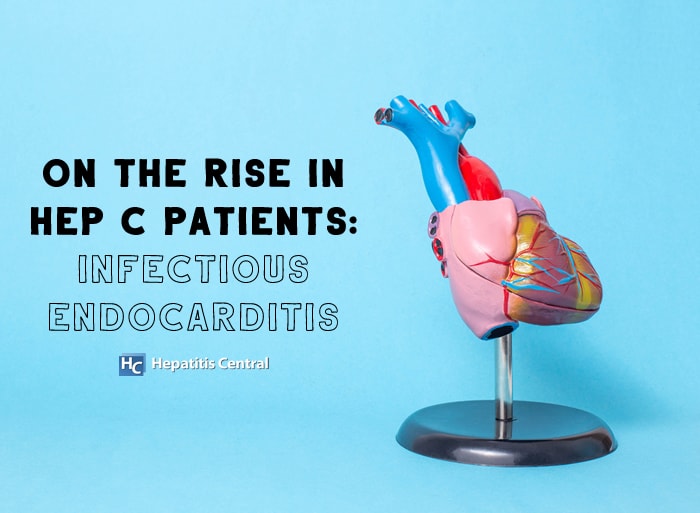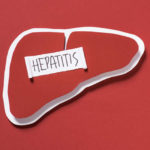On the Rise in Hep C Patients: Infectious Endocarditis


The Connection Between Hepatitis C and Infectious Endocarditis
It has been recognized since at least 1995 that the incidence of infectious endocarditis (IE), a serious infection of the heart, mirrors the use of injection drugs. This suggests that this reason – and not impaired immunity – is the most important risk factor for developing this illness.
People who inject drugs are at high risk for hepatitis C (HCV) infection and the two problems frequently coexist with each other. (1)
Infectious endocarditis represents a potentially fatal bacterial infection of the heart valves. It is most frequently diagnosed in the older population due to prosthetic heart valves or other devises. The other most prevalent risk factors for IE are in persons who inject drugs and who are opioid abusers, or who have HIV or HCV.
Among persons who inject drugs, infectious endocarditis stems from probable damage to the lining of the valve from injected pollutants, clot formation, and bacterial aggregation such as with staphylococcus aureus.
IE has increased in parallel with injection drug use. Data from the Health Care and Utilization Project National Inpatient Sample dataset showed an increase in IE hospitalizations from intravenous drug use that rose from 7% in 2000 to 12.1% in 2013. People with IE and who use intravenous drugs, have increased mortality after valve replacement and an increased frequency of repeat endocarditis. (2) IE is now most frequently seen in young people who are intravenous drug users or who have HCV or both.
The most recent trends in hospitalizations show a 60% increase in admissions between 1996 and 2003 for intravenous drug use IE. (2) This data was published before studies that described the increase in opioid use in the U.S., and was also likely underreported because of the illicit nature of the drug use and the reluctance of individuals to admit using them. Opioid use and intravenous drug use are closely related, and opioid use disorder is related to infectious endocarditis.
Another trend we cannot ignore when looking at data from studies is the fact that many hepatitis C positive individuals do not know they are positive. If such knowledge is not known, it is difficult to draw correlations between HCV infection and IE.
It is estimated that of 840,000 individuals who injected drugs between 2010-2017, that many may have missed being tested for the hepatitis C virus. Men in rural America seeking care for endocarditis or skin infections were the ones most likely to miss out on the testing. Just under 8% had a test for hepatitis C. (3) The CDC estimates that 12.8% do not even know they have an infection with HCV.
What Does the Research Say About HCV and IE?
A study recently described in the Clinical Infectious Diseases Journal analyzed data from commercial and Medicaid health insurance databases to gain an estimate of the national endocarditis trends between 2007– 2017. (4) Their overall findings were that, out of 100,000 people, there were 14 cases of IE among commercial insurances, yet 79 cases in the Medicaid population. The reason given for this disparity was poverty and socioeconomic status. (4)
The cases of IE among people with HIV declined by 4.3% annually, falling from 148 cases per 100,000 people to 112 cases in 2017. Contrary to this, HCV patients increased from 172 cases in 2007 to 239 cases ten years later, for an annual increase of 3.2% in IE cases in patients aged 18-29. This time period saw the rate increase from 322 cases to 1,007 cases among people between 18-29 years old who were HCV positive. This represents an average of a 16.3% annual increase in cases. In addition, the rate increased among the population with opioid use disorder from 156 cases to 643 cases representing an annual increase of 14.8%. (4)
Opioids and other drugs are frequently injected, and sharing of equipment only increases the risk of acquiring HIV and HCV – as well as other soft tissue infections. Furthermore, poor injection technique increases the risk of IE and soft tissue infection, which is only made worse if dealing with a compromised immune system.
Conclusion
In conclusion, the increasing trend in IE among persons with HCV infection more than likely reflects the recent trends in intravenous drug use in this population group.
Between 2010 and 2017, reported cases of acute HCV case more than tripled. (4) Intravenous drug use is one of the most common risk factors for acquiring hepatitis C. Forty-four thousand new cases were reported in the 7 years since 2010.
Infectious endocarditis is a serious condition associated with significant mortality and morbidity, making any treatment protocol expensive and thus emphasizing the need for prevention. IE can be prevented by implementing harm reduction interventions, such as syringe services programs and medications for opioid use disorder. This includes methadone and extended release naltrexone, as well as buprenorphine.
IE can also be prevented by practicing safe hand hygiene and aseptic injection techniques. Teaching safe injection techniques and infection control procedures may not stop drug abuse, but may make the drug use safer until prevention programs can be accepted and implemented.
- Currie, P.F., Sutherland, G.R., Jacob, A.J., Bell, J.E., Brettle, R.P., Boon, N.A. ((1995). A review of endocarditis in acquired immunodeficiency syndrome and human immunodeficiency virus infection. European Heart Journal, 16:15-18. Retrieved from https://pubmed.ncbi.nlm.nih.gov/7671917/
- Wurcel, A. G., Anderson J. E., Chui, K.K., Skinner, S., Knox, T.A., Snydman, D., R., Stopka, T.J. (2016). Increasing infectious endocarditis admissions among young people who inject drugs. Open Forum Infectious Diseases. Retrieved from https://doi.org/10.1093/ofid/ofw157
- (2020, February 27). 90% of people who inject drugs in United states missed opportunities for HIV or hepatitis C tests. Info Hep. Retrieved July 9,2020 from http://www.infohep.org/90-of-people-who-inject-drugs-in-United-States-missed-opportunities-for-HIV-or-hepatitis-C-tests/page/3548532/
- Wong, C.Y., Zhu, W., Aurigemma, GP, Furukawa, N, Teshale, E. H., Huang, Y.A. Peters, P.J. Hoover, K. W. (2020). Infective endocarditis among persons aged 18-64 years living with human immunodeficiency virus, hepatitis C infection, or opioid use disorder, United States, 2007-2017, Clinical Infectious Diseases. Retrieved from https://doi.org/10.1093/cid/ciaa372







